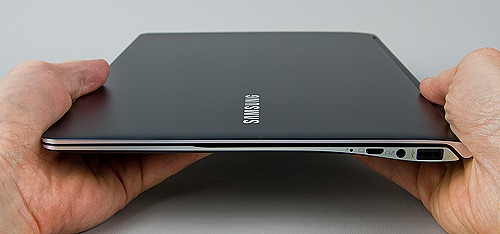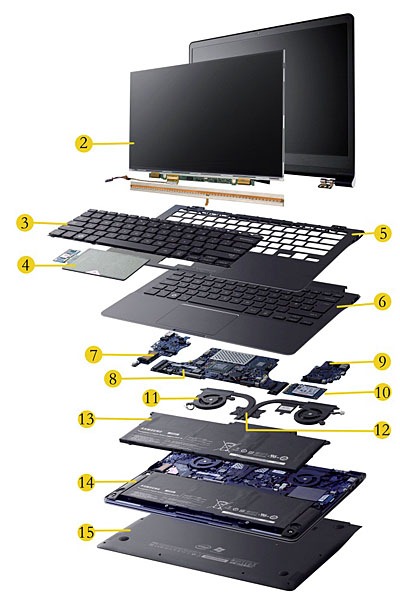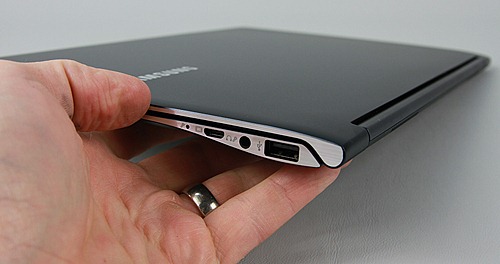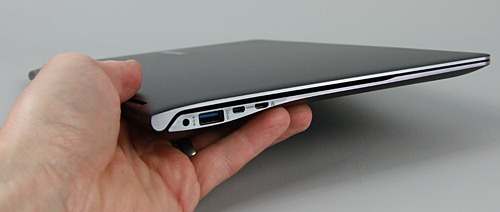Selecting a mobile PC is a process of balancing trade-offs. Screen size, computational horsepower, battery life, weight, size, and price are all factors that vary from one type of laptop to another. In the past, you had to choose between capabilities like battery life, size, and performance. These tradeoffs are becoming less pronounced with the new crop of thin and light laptops. With these PCs, you can enjoy ultra-mobility, great battery life, and have the power to run popular consumer or enterprise apps. In this post I’ll talk about the latest thin and light laptop from Samsung: the Series 9 (13.3” in this case, 15” models are also available).
If you want to push the limits of mobile computing technology, you have to take on significant engineering and manufacturing challenges. This is exactly what Seong-Woo Nam, Executive Vice President of the IT Solutions Business at Samsung did in late 2011. Seong-Woo Nam challenged Samsung engineers to shave 3.44mm off the already thin 16.33mm Samsung Series 9 laptop (first generation) that was in production at the time. Samsung succeeded in bringing this 12.9mm updated Series 9 machine to market in early 2012, an impressive accomplishment.
So how do you reduce the thickness of an already thin laptop by more than 20%? The answer is by examining every component that makes up the laptop, and by shrinking the thickness of most major components. Translation: this is a very highly engineered machine with tons of “custom” components that were designed specifically for this laptop. While the size of the machine was reduced, the list of capabilities is impressive: SSD for fast boot, USB 2.0 and 3.0 for great peripheral connectivity, ultra bright 400 nit screen, great battery life, and more.
I had a chance to get my hands on a couple variations of this updated Samsung Series 9, including the 900X3C (Intel Ivy Bridge version), and the 900X3B (Intel Sandy Bridge version). These models (13.3” screen) are pretty much identical with the exception of the processor utilized. When I first picked up this laptop, I was impressed with the “thinness” and the solid feel of quality. I asked myself: how did Samsung do that?
Engineering the World’s Thinnest Laptop
The engineers at Samsung started work on the updated Series 9 design by re-thinking the enclosure of the PC. This updated Series 9 would be built on an aluminum chassis machined from a solid billet with diamond tipped cutters. The resulting stiffness, lightness and finish (sandblasted and painted in most visible areas) are quite impressive. In addition to re-thinking the outside of the laptop, all of the major internal components were updated or optimized as well. The following image shows an exploded parts view of the new Samsung Notebook Series 9:
Image courtesy of Samsung Electronics
Components:
- 2: Display
- 3: Keyboard
- 4: Touchpad
- 5-6: Keyboard exterior
- 7-9: Main board (PCB circuits)
- 10: SSD
- 11: Fan
- 12: Heat pipe
- 13: Battery (lithium polymer)
- 14: Speaker
- 15: Bottom unit
It’s not enough to just make the parts thinner and lighter, they also need to perform well. Samsung has a series of stringent tests that are conducted on laptops before they are certified for mass production. This Series 9 update imposed some big certification challenges due to the fact that so many components were being redesigned, and dimensions being squeezed as small as possible at the same time.
After countless hours of engineering iterations and testing Samsung was able to meet their stringent criteria, and the updated Samsung Series 9 was unveiled at CES 2012 (the entire project was completed in a matter of a few months).
Some of the design highlights for the updated Series 9 include custom ports that are exposed in an elegant fashion on both sides of the laptop. On the right side (above image) we see the microphone, display port connector, microphone/headphone jack, and USB 2.0 port.
On the left side of the laptop (above image) we see the power jack, USB 3.0 port, micro HDMI port, and network port (network dongle is supplied with PC). You can tell from looking at these ports that quite a bit of thought and engineering craftsmanship went into the design.
One of the features that makes the Samsung Series 9 attractive to enterprise customers is the available TPM (Trusted Platform Module) chip. With this hardware capability, you can use many Windows productivity features like virtual smart cards, bit locker, and direct access.
How thin and how light can laptops get? That’s a good question. There’s always the need to balance the trade-offs between structural rigidity and overall thickness (imposing a theoretical limit on how thin a laptop can get). Samsung did a great job managing these trade-offs that off with the latest Series 9 machine!
Samsung Series 9 13.3” Specifications: (NP900X3C-A03US)
- CPU: Intel® Core™ i5-3317U Processor, 1.7 GHz
- Display: 13.3” 1600×900, 400 nits, LED HD+
- Memory: 4GB DDR3
- Storage: 128GB SSD
- Graphics: Intel HD Graphics 4000
- Dimensions: 12.3″ x 8.6″ x 0.50″, 2.55 lb
Full specifications are available on the Samsung website.
You can follow me on twitter here: @GavinGear





